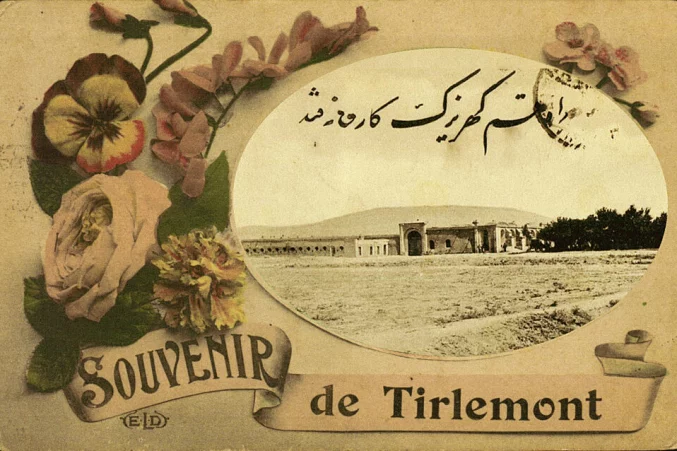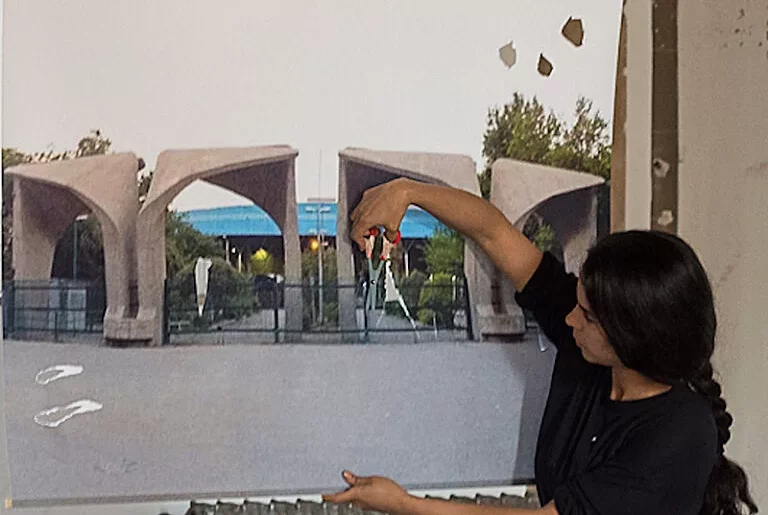Biography
Sana Ghobbeh is an Iranian-born artist and artistic researcher based in Brussels. Her work examines the life and the impact of specific sites of infrastructure, often situated in Iran. In her transdisciplinary approach, Sana integrates insights from her studies in architecture and research methods developed as a visual artist into a performative storytelling practice.Sana studied Architecture in Tehran and received a master’s degree in Fine Arts in Sweden. She worked as a research assistant at Umeå university of Architecture, before moving to Brussels in 2016.Her works focus on our interaction with particular architectural elements and how a performer can engage with disrupted urban spaces and transform them into an evolving context of engagement. Aided by concrete spatial installations on stage, that transform as each web of stories unfolds, Ghobbeh evokes the passing of major social events, small subversive gestures, and the traces these left in the urban fabric. Can new narratives rise up by tracing these moments of disruption, interruption, and poetry?
In this long-term research, Performing Spaces — an exploration on urban structures and their inner narratives —, Sana interweaves layers of archival documentation, individual memories, anecdotal interviews, minute details, historical facts, and personal imagination. Through this multifaceted approach, she aims to provide not only an informative, mapped understanding of a place but also a tangible sense of the often-overlooked politics and poetics that inhabit these spaces.As part of this investigation, Sana Ghobbeh created the performances “This wall grows at its roots” and “The ferris wheel turns when the wind blows”. She then got grant support for the Sugar CUBES project, a research into the history of sugar production, shapes, and the industrial ties between the sugar industries of Belgium and Iran. This led to the creation of the performance “These roots never blossomed” premiering at Beursschouwburg in spring 2025.
In residentie Sugar CUBES
01.08.2024 – 01.08.2024

In 2024 Sana Ghobbeh got the support of the Flemish government for the research and creation of a new performance. For the first time she would be working with a site of public infrastructure that she had not been present at physically herself: The ruins of the Kahrizak sugar factory.
To mitigate this lack of embodied knowledge, Sana set up an extensive research project, Sugar CUBES, to explore the historic ties between Belgium’s sugar industry and the foundation of the Kahrizak sugar refinery, to familiarise herself with the beet-based process of sugar production that was used in both cases, to dig through archives for traces of Belgian families that went to live in Iran to help set up the factory, looking for parallels and divergences in the stories of Kahrizak and Tienen.
The sugar factory in Tienen, Belgium, where the famous sugar cube was invented, is a story of succes. It is still an economic powerhouse for the city and country, and members of the family that founded it are some of the richest Belgians alive. In stark contrast, the factory in Kahrizak, that was founded with the help of Belgian industrialists, is now a ruin. A place that has become hard to find, crumbling behind old walls and newer residential areas that hide it away from sight. The site is listed, officially recognised as one of the earliest examples of industrial architecture in Iran. But in reality it is unprotected, a forgotten slice of history, a connection people no longer remember and care for.
During this research a factory visit to the sugar refinery in Tienen was made, to learn about both the history of the factory and the technicalities of the refining procedure, gathering as well an embodied knowledge of how tons boiled beets can make a certain smell embrace a city.
We talked with the curator of the local historical museum to learn how the relationship between the factory and the city had evolved over time, and we got in touch with the city archives to explore the traces of historic sugar products made for Iranian export, the construction of the Kahrizak sugar refinery, and the visit made by the Shah or Iran to Tienen in the 1960s.
The many knowledges deepened by this research allowed Sana to recreate and re-imagine her own understanding of the Kahrizak site, which led to the creation of the performance These roots never blossomed.

